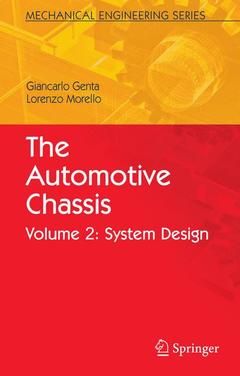SYMBOLS LIST; III FUNCTIONS AND SPECIFICATIONS: INTRODUCTION TO PART THREE: 17 TRANSPORTATION STATISTICS: 17.1 Traffic volume; 17.2 Operating fleet; 17.3 Social impact; 18 VEHICLE FUNCTIONS: 18.1 Systemdesign; 18.2 Objective requirements; 18.3 Subjective requirements; 18.4 Aging resistance; 19 REGULATIONS: 19.1 Vehicle system; 19.2 Wheels 19.3 Steering system; 19.4 Braking system; 19.5 Structures; 19.6 Gearbox; IV THE CHASSIS AS A PART OF THE VEHICLE SYSTEM: INTRODUCTION TO PART FOUR: 20 GENERAL CHARACTERISTICS: 20.1 Symmetry considerations; 20.2 Reference frames; 20.3 Position of the center of mass; 20.4 Mass distribution among the various bodies; 20.5 Moments of inertia; 21 AN OVERVIEW ON MOTOR VEHICLE AERODYNAMICS: 21.1 Aerodynamic forces andmoments; 21.2 Aerodynamic field around a vehicle; 21.3 Aerodynamic drag ; 21.4 Lift and pitching moment; 21.5 Side force and roll and yawmoments; 21.6 Experimental study of aerodynamic forces; 21.7 Numerical aerodynamics; 22 PRIME MOVERS FOR MOTOR VEHICLES: 22.1 Vehicular engines; 22.2 Internal combustion engines ; 22.3 Electric vehicles; 22.4 Hybrid vehicles; 23 DRIVING DYNAMIC PERFORMANCE: 23.1 Load distribution on the ground; 23.2 Total resistance to motion; 23.3 Power needed for motion; 23.4 Available power at the wheels; 23.5 Maximum power that can be transferred to the road; 23.6 Maximum speed; 23.7 Gradeability and initial choice of the transmission ratios; 23.8 Fuel consumption at constant speed; 23.9 Vehicle take-off from rest; 23.10 Acceleration; 23.11 Fuel consumption in actual driving conditions; 24 BRAKING DYNAMIC PERFORMANCE: 24.1 Braking in ideal conditions; 24.2 Braking in actual conditions; 24.3 Braking power; 25 HANDLING PERFORMANCE: 25.1 Low-speed or kinematic steering; 25.2 Ideal steering; 25.3 High-speed cornering: simplified approach; 25.4 Definition of understeer and oversteer; 25.5 High-speed cornering; 25.6 Steady-state lateral behavior; 25.7 Neutral-steer point and static margin; 25.8 Response to external forces and moments; 25.9 Slip steering; 25.10 Influence of longitudinal forces on handling; 25.11 Transversal load shift; 25.12 Toe-in; 25.13 Effect of the elasto-kinematic behavior of suspensions and of the compliance of the chassis; 25.14 Stability of the vehicle; 25.15 Unstationary motion; 25.16 Vehicles with two steering axles (4WS); 25.17 Articulated vehicles; 25.18 Multibody articulated vehicles; 25.19 Limits of linearized models; 26 COMFORT PERFORMANCE: 26.1 Internal excitation; 26.2 Road excitation; 26.3 Effects of vibration on the human body; 26.4 Quarter-car models; 26.5 Heave and pitch motion; 26.6 Roll motion; 26.7 Effect of nonlinearities; 26.8 Concluding remarks on ride comfort; 27 CONTROL OF THE CHASSIS AND ‘BY WIRE’ SYSTEMS:27.1 Motor vehicle control; 27.2 Models for the vehicle-driver system; 27.3 Antilock (ABS) and antispin (ASR) systems; 27.4 Handling control; 27.5 Suspensions control; 27.6 By wire systems; V MATHEMATICAL MODELLING: INTRODUCTION TO PART FIVE: 28 MATHEMATICAL MODELS FOR THE VEHICLE: 28.1 Mathematical models for design; 28.2 Continuous and discretized models; 28.3 Analytical and numerical models; 29 MULTIBODY MODELLING: 29.1 Isolated vehicle; 29.2 Linearized model for the isolated vehicle; 29.3 Model with 10 degrees of freedom with locked controls; 29.4 Models of deformable vehicles; 29.5 Articulated vehicles; 29.6 Gyroscopic moments and other second order effects; 30 TRANSMISSION MODELS: 30.1 Coupling between comfort and drive line vibration; 30.2 Dynamic model of the engine 30.3 Drive line; 30.4 Inertia of the vehicle; 30.5 Linearized drive line model; 30.6 Non-time-invariant models; 30.7 Multibody drive line models; 31 MODELS FOR TILTING BODY VEHICLES: 31.1 Suspensions for high roll angles; 31.2 Linearized rigid body model; 31.3 Dynamic tilting control; 31.4 Handling-comfort coupling; BIBLIOGRAPHY OF VOLUME 2: A EQUATIONS OF




